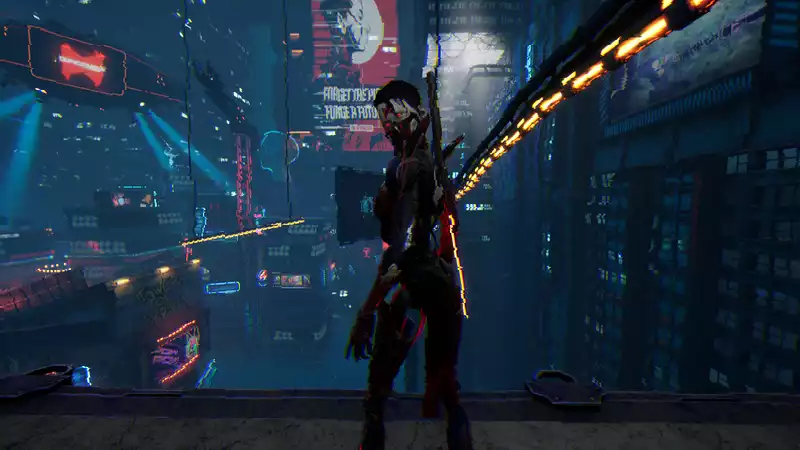The basic concept is straightforward and faintly frightening. Enemies die in a single blow. In this game, you can die (more times) on one level than in the entire rest of the game. It is brutally, unforgivingly hard, but it is fair in a way that some unpleasantly difficult games would not even try to be. I have brought a knife into a gunfight and I love it. I never get tired of cutting people in half.
There is no sprint button. If you are moving, you are running. Most enemies have guns and they are all very skilled. There is no time for quiet contemplation while you are in the air or running along a wall. If you miss a jump or react too late to jump to the next wall, you will fall to your death in a heap. You are like a stray dog that is always on the move, has excellent parkour skills, and has nothing to lose.
This is a cyberpunk game, recognizable by the fact that everything is dirty, characters have robotic arms, and there are roofs with big neon signs. It's a visually interesting place to kill strangers, but it's a bit of a wild ride in terms of world building. The story doesn't help. Despite the fact that there is often someone chattering in your ear, there is no strong narrative to hold it all together. Something about betrayal, something about evil rulers, something about human experimentation. ...... Ridley Scott and Quentin Tarantino co-directed this Saturday morning animated feature.
Frankly, it doesn't matter. This is all about putting yourself in the moment, putting together the perfect sequence of events, and moving on to the next area in style Ghostrunner is awesome. Bouncing between walls, jumping to the floor, dodging bullets at the last second, slicing through two enemies in a row, running while holding onto a wall, jumping down again, and slipping under a giant laser to destroy the mech that sent you there is a thrill like no other. There are going to be some great YouTube videos and Twitch feeds of this game.
Nonetheless, the Ghostrunner appears to occasionally try to stab itself in the foot. There are a number of times when the player moves through the "cybervoid," the blocky electronic space between areas. Sometimes this serves as a tutorial area for new abilities, which is fine. But more often than not, it is used to drag the player into a tedious puzzle. There is absolutely no reason for these sequences to exist, and they completely kill the pace and atmosphere. Fortunately, cybervoiding makes up a minority of the experience.
Back in the "real" world, things are very well designed to avoid foreseeable pitfalls. The gradual introduction of new enemies and environmental elements prevents monotony without being overwhelming. Importantly, checkpoints are set up to keep things streamlined without reducing the difficulty.
The level is essentially divided into chunks, with a series of enemy encounters and tricky platforming divided by checkpoints. Each fight is essentially a blood-splattered parkour puzzle. I was worried that the game would be one where you would have to follow a strictly defined path, but that is not the case at all. Each arena usually offers at least two routes, and it's entirely up to you which order you take down your enemies. Personally, I prefer to destroy the shield generator first so that everyone is defenseless at once, then take out the walking mechs first with a huge laser blast, and then everyone else depending on the threat. Leave the soldiers with their shields facing forward last, and gleefully humiliate them by going behind them at close range before turning them inside out.
Bosses aside, there are two types of enemies that twist the one-hit-kill premise a bit and produce very different results. Ninjas are usually impossible to take down without parrying, so it's best to avoid them until you can't see their guns. Near the end of the game, the most unoriginal and annoying enemy type appears: the one that explodes if you get too close. These appear indefinitely until all other enemies in the area have been defeated, thus seriously undermining any sense of freedom of choice. It is no fun to die when you accidentally encounter one around a corner or get hit by one without realizing it is right behind you. Thank goodness they only appear for a relatively short time.
There are a total of four abilities that are unlocked during the game: three basically allow you to kill enemies from a distance, and the fourth temporarily turns enemies into allies (very fun). The upgrade system is linked to these in an interesting way. The more upgrades you have equipped (such as a sword that makes it easier to deflect bullets or mark collectibles on the radar), the slower the focus bar charge required to passively use these abilities (which is boosted when you kill). Like every moment of play, risk/reward is important.
The wall-run ability is excellent for moving smoothly between surfaces, but the parkour sequence seems to have been tested only by those with perfect runs. When I miss a jump, there seems to be a 50-50 chance that I will fall into a part of the landscape that I am not supposed to fall into. When this happens, I sheepishly step out into the void, sometimes falling 20 centimeters to my death.
Flawed but not fatally flawed, Ghostrunner wants to make you feel like a cybernetically enhanced badass, and it almost always accomplishes that admirably. Tough, fair, and fun.
.

Comments